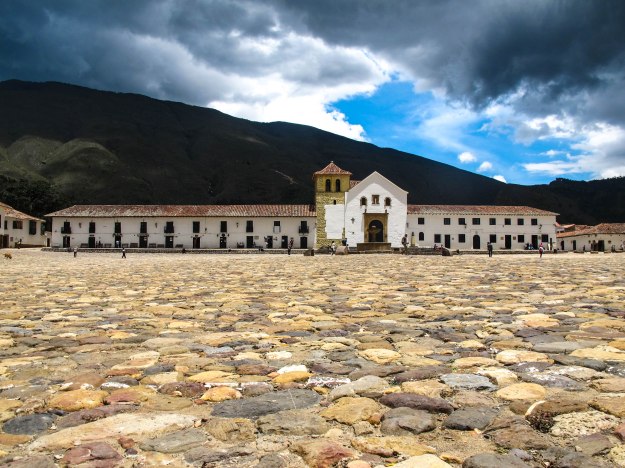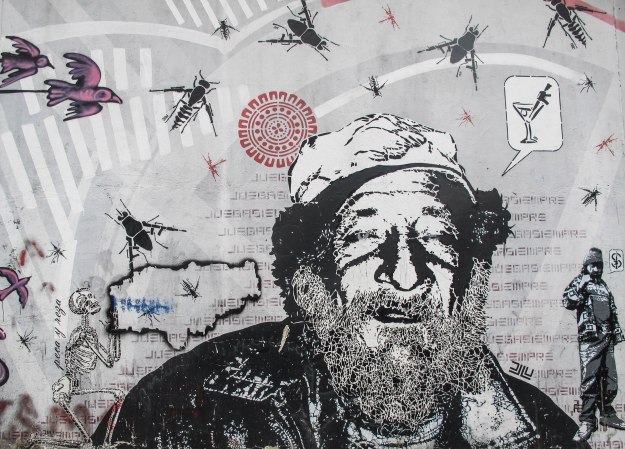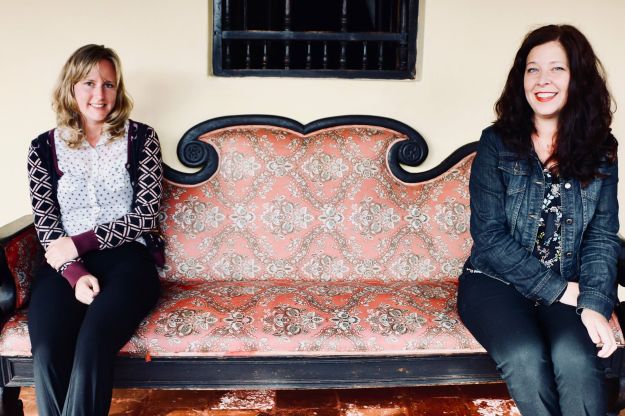
It was back to Colombia again over Spring Break. The city of Bogotá was our destination. We avoided Avior Airlines through Valencia this time since it was recently added to the EU ban list. Instead, we booked tickets with Panamanian Copa Airlines and enjoyed a relaxing journey from Aruba to Colombia, except for the sprint to catch our connecting flight at the airport in Panama City. The best thing about flying in South America is its retro effect, as they serve you an in-flight complimentary hot meal with wine. It feels as if you have been transported back to the 1960s, back when they did this full-service kind of thing on airlines in the United States. I was waiting for a stylish flight attendant to offer me slippers and tuck me in under a blanket after dinner was served. Avianca, by the way, has the most glamorous flight crew throughout the Americas, quite possibly the entire planet: the flight attendants wear red capes and Bowler hats.
We landed in Bogotá that evening and hailed a taxi outside the airport. After an inquisition about cab fare forced upon our taxi driver by my Dutch travel mate while I haphazardly translated numbers from Spanish to English in rapid-fire succession, we held on tight for the roller coaster ride that we clearly were not paying more money for just because we were tourists. After twenty minutes of gripping the grab handle, we watched with anticipation as the stick shift choked up a steep street to our final destination in the Candelaria sector of the city. At the top of the hill, we were catapulted out from the back seat onto the narrow cobblestone sidewalk, weighted down by heavy backpacks and travel fatigue. Finding our footing after wobbling about in front of the hotel, we realized we had the right place but that the door clearly didn’t fit us. It was a door from a period long ago when people were a few inches shorter than they are today, and the city didn’t regularly welcome visitors from a country that breeds the tallest people in the world.
My Spanish speaking skills have improved somewhat since our last trip to Colombia when we toured Medellín and its outskirts. It’s a work in progress, albeit progress that moves at the same pace it would take an ant colony to build a hill the size of a haystack. Checking into the hotel was my first test. Last time we survived on the twigs of Spanish words and phrases that I could comprehend and toss back out to get us from point A to B or safely checked into a hotel room at night. This time I understood everything one could ever want to know about Hotel Muisca as we checked into our room that evening. My facial expression didn’t go blank every time the lady behind the counter started speaking. I listened attentively as she gave instructions and then answered her questions without pause, realizing shortly thereafter that progress had been made in the language learning endeavor.
We climbed upstairs to our room, changed clothes, and broke the first rule for women traveling in Bogotá: Don’t walk the city streets late at night. Actually, I’m the only one who tries to follow these rules. My Dutch friend shrugs them off as American created and spawned from ignorance and paranoia. What does your country know about this place? I agree with her for the most part, but there are times when I feel vulnerable, not as a result of my nationality, more so because of my gender. She got to the point where she just stopped responding to my comments. “I don’t think we are supposed to hail a cab on the city streets after dark in Bogota,” I would inform her, anxiously pleading a case to preserve my life as we walked along the side of a busy street under a shared umbrella while it was raining cats and dogs. I heard nothing in response to my comment, just colossal drops pounding around us while cars rolled along, splashing puddles of water. These are the moments when I ask myself silently: Am I really just a hysterical American, or does my friend have some kind of a Dutch deathwish? Tonight it was time to break the first rule. We were walking to Plaza Churro de Quevedo. Who cares that it was almost eleven? It was time to venture out into the nightlife of Bogotá.
Like most rules I break, I’m glad we did it, or we would have missed out on a magical night. We both agreed Churro de Quevedo felt like a plaza in Rome. People were sitting on the steps all around us. How special is it that you can find something like this in the Americas? No need to travel to another hemisphere to visit the Old World. Here century-old homes had become taverns, so we stepped inside one to order a drink, climbing a narrow staircase that felt more like clambering up a ladder, eventually leading us up above to a cozy room. Dressed in layers and jackets, we were bundled up for a chilly evening outside, and the whole scene inside was quite gezellig, providing a much-needed contrast to the tropical Aruban heat where our day began. The room had an A framed roof and endless windows with wooden shutters opened so we could take in the view of the plaza below. People were nestled into sofas all around us. This was somebody’s bedroom once. And here we were, hundreds of years later, arriving on a jet plane that evening and enjoying our first cocktail in beautiful Bogotá.
Arriving anywhere in Colombia at night is the only way to go because the morning sun brings some magic as you take your first blissful glimpse of wherever it is you’ve landed. And Colombia never disappoints. That first step outside is a gift in sight that will make your heart skip a beat, leaving behind a visual moment in your memory that will last forever. We discovered we were high up on a hill with a breathtaking view of Bogotá beneath us. A never-ending expanse of buildings hemmed in by lofty mountains, all under a canopy of immense silvery clouds. It was Good Friday, and we were headed to Plaza Bolivar, the largest in Bogotá. Nothing compares to finding your way to a plaza in a Latin American country on any given Catholic holiday, and this weekend just happened to mark a really important one on the calendar.
After taking in the ceremony, we were ready to visit Centro Cultura Gabriel Garcia Marquez. We made our way down the bustling street where crowds gathered around artists spray painting portraits of Christ onto the pavement while vendors sold fruits I could not identify. Once we reached the cultural center, I went to the bookstore and bought a hardcover copy of One Hundred Years of Solitude in Spanish.
Later that afternoon, we walked across the city to Monserrate and bought a ticket to take the cable car up to the top. We never got in line because we never found the end. The whole city of Bogotá seemed to be waiting in line to go to the top since it was Good Friday, and the cable car tickets were cheaper today because Jesus would want everyone to be able to go to the top of Monserrate, not just the wealthy. Giving up on that particular agenda item, we returned to the hotel and collapsed. We decided we were running low on fuel because we hadn’t eaten since breakfast, so we made our way out the door and walked all around, looking for a dinner spot that was open. We finally found a place, and I compensated for our failed attempt to ride the cable car up a mountain by ordering a tamale that was as big as my head.
The next day we had a 10 AM tour with Bogotá Graffiti Tour. These were my favorite few hours spent in the city and a must-do for anyone planning a visit. The crowd was larger than expected; a group of about thirty to forty turned out under our meeting spot at the statue of Símon Bolívar in Parque de los Periodistas. Our tour guide took us all over the city and stopped frequently to deliver museum-style lectures for the most famous of the city’s collections. The tour ended downtown in front of a classic piece by DJ Lu. Each iconographic detail from the city block-length mural was deciphered by our expert guide to piece together the artist’s collective commentary on corrupt politics and social injustice for the tour group. From there, we went to Museo del Oro and Museo Botero, a full day soaking in all of the art that makes Bogotá such a special place.

The next day was Easter Sunday. We packed our bags and were on our way to the colonial town of Villa de Leyva, stopping at the Mercado de Las Pulgas de Usaquen en route to the bus station. Mercado de Las Pulgas de Usaquen is a Sunday flea market where we spent most of the afternoon perusing the maze of vendors selling artisan handicrafts and tasty food products and everything else imaginable. From there, we took a taxi to the bus terminal north of the city. Taking a bus in Colombia is an experience in and of itself. I’ve never seen another tourist on the many bus rides we’ve taken in Colombia. It’s my favorite way to travel because you can sit back and stare out the window, hypnotized by the beauty of the land. Once we boarded the bus, it began pouring down rain and so since I could not see beautiful land out the window, I became more interested in our bus driver.
We were sitting directly behind her, which gave me a clear view of her cell phone mounted next to the steering wheel. I had never seen a female bus driver in this machismo society, especially one chatting on WhatsApp while piloting a behemoth bus down slick winding roads through the Andes in a torrential storm well after dark. I was utterly transfixed by this character. She was a vivacious type, beautiful and flirtatious, who joked around with all the handsome men working for Expreso Gaviota, the name of the company painted on the side of the bus. She was in complete command over this machine and all the men who kept things churning along for this bus line. I had so many questions. Who was this woman? And how did she end up behind the wheel of a bus in this country?
My questions were eventually answered over the course of a four-hour trip, during which I would steal random glances from her cell phone screen. At first, she used her phone to scroll through her playlist and select songs the same way anyone would as they set out on the first 100 miles of a road trip. That was when it was still daylight. Every once in a while, she would chat with a friend via text or talk. Once we got closer to Villa de Leyva, the cars were at a standstill on the other side of this two-lane highway as thousands of people were returning to Bogotá from Villa de Leyva where they had spent Easter weekend. Then she took pictures of all the oncoming traffic and sent them off to others on WhatsApp. Eventually, as the sun set and darkness enveloped the land all around while the rain kept pounding down, she began to obsessively dial a number over and over and over again. Maybe women shouldn’t be driving buses.
My eyelids were heavy, but this compulsive act caught my attention and kept me awake. I noticed the name she kept dialing ended with Gaviota, so I assumed she was calling el jefe. But then I thought the behavior was indicative of a mind that was unstable enough to get one fired from a job as the only female bus driver between Bogotá and Villa de Leyva. I certainly would not be able to keep a job if I called my boss 15 times. In addition to my question about how she got a job as a bus driver, I now had more questions about how she kept it. Eventually, someone picked up on the other end. “Papa,” she exclaimed. The mystery was solved just minutes before we arrived at our destination. She must be the heiress to the Gaviota fleet.
We arrived late in the Boyocá town of Villa de Leyva and walked 30 minutes to our hotel from the drop zone, where the bus stopped. Built in 1568, La Mesopotemia Hotel Colonial was once an old flour mill, and staying inside this 450-year-old colonial house transported us back to another era in time. I may have to add it to my list of top ten favorite places I have ever stayed in Latin America. It even had a swimming hole on the grounds. Actually, all of Villa de Leyva has been declared a National Monument, and the entire town feels like a time capsule.
There are five details about Villa de Leyva that I find fascinating. First, the cobblestone square is the largest in all of South America. Second, there are fossils nudged inside random structures all over town. Its location is some kind of mecca for paleontologists, and the earliest stonemasons thought the ammonites strewn about the environs of town could serve both decorative and structural purposes. They, therefore, embedded them into archways and cornerstones all over the place. Third, it is home to the lake where, according to Muisca legend, humankind emerged in the form of a woman holding a baby. The two carried forth from there, populated the entire planet, and then turned into snakes, disappearing back into the water. Fourth, it is located near an archaeological site where the Muisca erected phallic stone monuments, which the Spanish named el infiernito (little hell) since they were horrified by these salacious stelae. Fifth, a bridge leading into the city was the site of a decisive legendary battle that Simón Bolivar and his army of Patriots won.
Our last day in Colombia was spent racing to take a wild tour of the Zipaquira Salt Cathedral and Andres restaurant in Chía en route back to Bogotá. To fit it all in, we had to make some insane bus transfers in the middle of nowhere. It just also happened to be pouring down rain yet again. It was another bumpy roller coaster ride along slippery mountain roads. Forget hailing a cab at night in the big city; the bus rides are really the most dangerous moments we’ve experienced throughout our travels in South America.
The first transfer occurred in Briceno, which was just an intersection where two roads met, and a yellow bus was waiting for us on a street that we had to make a mad dash across in a torrential downpour. Zipaquira was quite the adventure, a salt mine cathedral that feels like traveling to a holy site in space, another world entirely, and just one stop on the agenda for the day. After touring Zipaquira for a couple of hours, the sun was beginning to set. We still had two more cities to reach before our plane took off in six hours. Time was of the essence, but it would be better spent drinking a beer inside a restaurant and graciously accepting any help the waiter who flagged us off the street could offer to get us into a cab before the sun dropped below the horizon.
With just a sliver of sunlight left, we climbed into a cab and were on our way to the bus station. The cab driver insisted we would never find a bus to Chía, but we knew that wasn’t the case based on our past experience of stopping in every town from one destination to another when riding buses in Colombia. We boarded an empty bus to Bogotå at the station, and I sat up front to keep the lines of communication open with the bus driver and his cohort, who would jump out of the bus at every intersection and shout out a long list of cities. I was in charge of Spanish, and my Dutch friend put her explorer genes to work by playing the navigator role, periodically opening Google Maps on her phone to ensure we were on the correct route. We were extra vigilant on this particular stretch because we couldn’t miss our stop. There was the problem of being stranded in some strange city in the middle of the night, but then we also had a plane to catch before breakfast.
We made it to the restaurant, one that friends who have visited and lived in Bogotá all recommended. It was as strange and bizarre as the salt cathedral in Zipaquira. Two otherworldly experiences within 4 hours and two wild bus rides in between. It was one of those days where I felt like I was fully doing this living life thing. Like, I’ve got it all figured out, and it just doesn’t get better than this. Traveling anywhere in Latin America typically makes me feel this way, and we’ve gained a lot of practice over the past few years. With two trips to Colombia and a summer in Peru and Bolivia in the books, we are headed to Chile and Argentina for the summer in just a few weeks.

`
